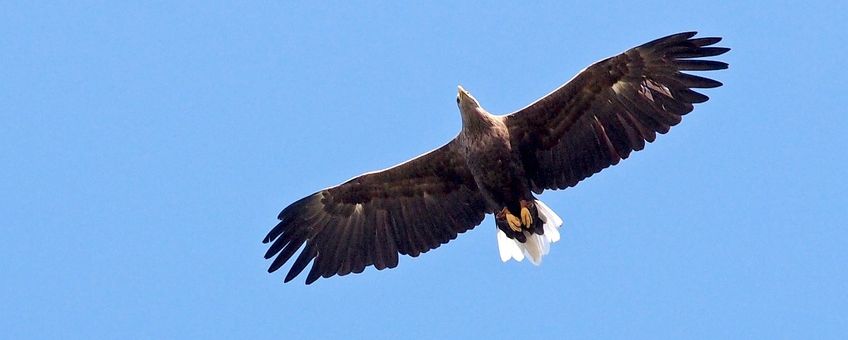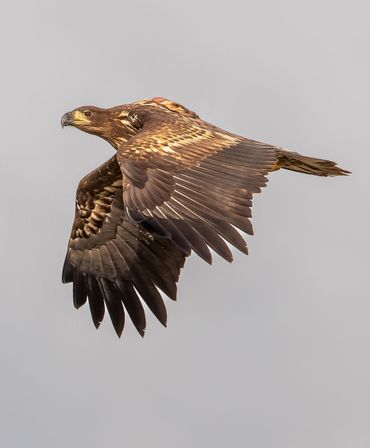
Birds of prey with GPS transmitters show the probability of collision with wind turbines
Grauwe Kiekendief - Kenniscentrum Akkervogels, Wageningen Environmental Research, Wageningen University & Research, Werkgroep Zeearend NederlandIn a new study by Wageningen Environmental Research with the Werkgroep Zeearend Nederland and Grauwe Kiekendief - Kenniscentrum Akkervogels, the knowledge on risks of collisions of white-tailed eagles and marsh harriers with wind turbines has been summarised for the province of Flevoland. The analyses are based on a sample of juvenile white-tailed eagles and marsh harriers equipped with GPS transmitters in 2019-2021.

Flight movements and flight altitudes determine risk of collision
The risk of collision with wind turbines is largely determined by the flight time of the raptors at the height of the turbine engines. However, weather conditions, time of day and season are also decisive.
A significant part of the flight time took place at rotor height. Within Flevoland, white-tailed eagles flew 34 percent of the flight time at turbine rotor height and marsh harriers 14 percent of the flight time. Most flights of both species took place at low altitudes below 25 metres, the lowest 'tip height' of turbine rotors in the province.
The results showed that weather conditions had a significant influence on the flight height of both raptors. Around noon, between 12.00 and 15.00, the birds flew most often at rotor height. Based on the flight movements and flight heights found, potential collision risk areas for both raptors were identified.
Replacement of turbines in Flevoland
The province of Flevoland is currently replacing old, small turbines that have a low tip height with a smaller number of larger turbines that have a higher tip height. With those replacements, both total power and total rotor area increase significantly.
Ralph Buij of Wageningen Environmental Research says: "In absolute terms, it is detrimental to white-tailed eagles and marsh harriers that larger turbines will be installed with the 're-powering' in the province, because the birds encounter more rotor surface that they can fly into. On the other hand, the collision rate per unit power for large turbines is a lot lower compared to small turbines. Therefore, if the province had opted for the same increase in wind power production with the older turbine models, the collision risk would have increased much more."
How do you reduce the risk of collision?
There are a number of ways to reduce collision probabilities of raptors with Flevoland turbines. The study shows that this can be done by establishing a shutdown period, such as shutting down turbines between 10:00 and 18:00 in the months of April and May. Analysis of GPS transmitter data shows that this already reduces the probability of collision by 26 percent for marsh harrier and 21 percent for white-tailed eagle. Another measure, which has already been proven effective elsewhere, is standstill based on camera detection of an approaching raptor. Another option – painting a single rotor black – was previously successful for some bird species in Norway, but effectiveness for raptors in the Netherlands has yet to be proven. Such measures should focus on the riskiest turbines, which have the most passing movements.
The most important measure still remains to avoid placement of turbines in areas where collision probabilities are high. The transmitter data of young white-tailed eagles show that the Flevopolders are crossed much more often than was assumed during the planning phase of the wind farms. The turbines in the polders just south of the Oostvaardersplassen are particularly risky, because the white-tailed eagles regularly commute up and down through those polders between the Oostvaardersplassen and wetlands in the south of the province and the Veluwe. Precisely there, two white-tailed eagles became victims of collisions with wind turbines in recent years.
Consequences for population size
The increase in the number of wind turbines meets the important demand for wind energy production, but at the same time negative effects on birds increase. Even with a small number of casualties, this can have significant consequences for some species. This is particularly problematic for slowly reproducing species, species already under pressure, or rare species, such as marsh harriers and white-tailed eagles.
Until now, little was known in the Netherlands about the chances of raptors colliding with wind turbines, and where and when those risks were big. This complicates taking effective measures to prevent mortality. The accurate flight data from the GPS transmitters provide new insights that make such measures possible.
This research was subsidized by the Provincie Flevoland and the ministerie van Landbouw, Natuur en Voedselkwaliteit, within the WUR Kennisbasisprogramma KB36 Biodiversiteit in een Natuurinclusieve Samenleving (projectnummer KB36-5200044844).
Text: Wageningen Environmental Research
Images: Hans Dekker, Saxifraga (lead photo: white-tailed eagle); Ralph Buij
